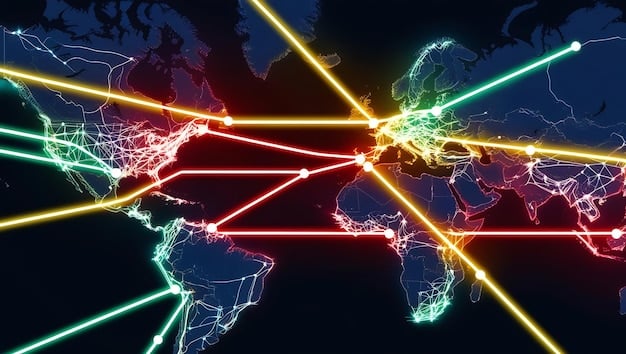Implications of New US Sanctions on Foreign Tech Companies

Advertisements
New US sanctions targeting foreign technology companies aim to protect national security and economic interests by restricting access to critical technologies, potentially leading to global supply chain disruptions, geopolitical realignments, and accelerated technological decoupling.
Advertisements
Understanding the far-reaching consequences of evolving geopolitical landscapes is crucial in today’s interconnected world. A critical development demanding our attention is the recent imposition of new US sanctions on foreign technology companies. So, what are the implications of the new US sanctions on foreign technology companies? This article seeks to dissect the multifaceted impacts, examining how these measures reshape international trade, technological innovation, and diplomatic relations.
Understanding the Rationale Behind the Sanctions
The US government’s decision to implement new sanctions on foreign technology companies stems from a complex interplay of national security concerns, economic competitiveness, and human rights considerations. These measures are rarely unilateral, often reflecting a broader strategy to exert influence and safeguard perceived national interests in a rapidly evolving global tech landscape.
Advertisements
A primary driver for these sanctions is often national security. Concerns about surveillance capabilities, intellectual property theft, and the use of foreign technology in critical infrastructure have led policymakers to adopt a more aggressive stance. The aim is to prevent adversaries from acquiring or leveraging technology that could pose a threat to US interests or those of its allies. This includes both defensive measures to protect sensitive data and offensive capabilities to maintain a technological edge.
Economic Security and Fair Competition
Beyond national security, economic considerations play a significant role. The US seeks to protect its domestic technology sector from what it perceives as unfair competition, including state-sponsored subsidies, forced technology transfers, and intellectual property infringement. Sanctions can be a tool to level the playing field, encourage reciprocal market access, and ensure the long-term viability of American tech companies.
* Preventing intellectual property theft and unauthorized technology transfer.
* Addressing state subsidies that distort global markets.
* Promoting fair market access for US tech firms abroad.
Moreover, the US often justifies these sanctions by citing concerns over human rights abuses, particularly in the context of surveillance technologies and their potential use in authoritarian regimes. While effective sanctions are difficult to implement, this moral dimension is frequently highlighted to garner international support and pressure targeted entities. This ethical component adds another layer of complexity to the geopolitical motivations behind such economic tools.
Ultimately, these sanctions represent a strategic effort by the US to shape global technology norms and supply chains. By restricting access to crucial components, software, or markets, the US aims to compel foreign entities to align with its policy objectives. This can lead to significant shifts in how technology is developed, produced, and disseminated worldwide, creating both challenges and opportunities for all involved parties.
Impact on Global Supply Chains and Technological Development
The imposition of new US sanctions on foreign technology companies inevitably sends ripples through the intricately woven fabric of global supply chains. In an era where technological innovation relies heavily on interconnected networks of research, manufacturing, and distribution, restrictions on key players can lead to widespread disruption, forcing a recalibration of established practices.
Supply Chain Redundancy and Diversification
One immediate consequence is the acceleration of supply chain diversification. Companies, both within the US and internationally, become acutely aware of their vulnerabilities to single points of failure, particularly when those points are subject to geopolitical tensions. This leads to a concerted effort to build redundancy and explore alternative sourcing strategies.
* Shifting production facilities to other countries.
* Investing in domestic manufacturing capabilities.
* Developing new partnerships with non-sanctioned entities.
This drive for diversification, while enhancing resilience in the long run, often comes with short-term costs, including increased production expenses, delays in product development, and the need to re-engineer existing designs to accommodate new components or software. Businesses find themselves navigating a new landscape where political risk analysis becomes as critical as market demand.
Accelerating Technological Decoupling
Perhaps the most profound long-term implication is the acceleration of technological decoupling. As the US restricts access to its core technologies, foreign entities, particularly those in sanctioned countries, are compelled to develop their own indigenous capabilities. This involves massive investments in R&D, talent acquisition, and the creation of alternative technological ecosystems.
This decoupling can lead to the emergence of parallel technological standards and infrastructures. Instead of a globally integrated tech landscape, we might see the rise of distinct, self-sufficient technological blocs, each with its own preferred technologies, operating systems, and communication protocols. This fragmentation could make global collaboration more challenging and potentially lead to slower overall technological progress due to reduced cross-pollination of ideas and resources. The implications for interoperability and global trade are substantial, pointing towards a future where digital borders become increasingly solidified.

Geopolitical Realignment and International Relations
The strategic weaponization of technology through sanctions profoundly reshapes geopolitical alliances and international relations. When a major economic power like the US imposes restrictions, it forces nations and companies to choose sides, sometimes subtly, sometimes overtly, leading to a realignment of diplomatic and economic partnerships.
Deepening Divides and New Alliances
Sanctions inevitably deepen existing divides between geopolitical rivals, solidifying a “us vs. them” mentality in the tech sphere. Countries targeted by sanctions are pushed further into developing alternative technological ecosystems, often forging stronger ties with other nations similarly affected or those seeking to challenge US technological hegemony. This can lead to the formation of new technology-focused blocs, each aiming for self-sufficiency and reduced reliance on external powers.
Conversely, allies of the US may face pressure to align their own tech policies with Washington’s, even if it comes at an economic cost. This demands a delicate balancing act for these nations, as they weigh their security interests and values against potential economic repercussions from alienated markets or interrupted supply chains. The long-term durability of existing alliances could be tested as each nation navigates its self-interest.
Impact on Multilateral Institutions and Norms
The frequent use of unilateral sanctions, particularly those targeting a broad range of technology companies, can undermine the authority and effectiveness of multilateral institutions like the World Trade Organization (WTO). These institutions are designed to promote a rules-based international order, and unilateral actions can be seen as circumventing these established frameworks. This erosion of trust in global governance mechanisms can make it harder to address other pressing international issues that require broad cooperation.
Moreover, the precedent set by technology sanctions challenges long-standing norms around free trade and global economic integration. It suggests that national security considerations can override economic efficiency, potentially leading to a more fragmented and less predictable global trading environment. Nations may increasingly prioritize self-reliance over comparative advantage, affecting global economic flows and fostering greater protectionism across various industries.
Economic Consequences for US and Foreign Businesses
The economic ramifications of new US sanctions ripple far beyond the targeted foreign technology companies, affecting businesses on both sides of the divide. While designed to achieve strategic objectives, these measures often come with a substantial economic cost, impacting revenue streams, market access, and the overall global competitive landscape.
For foreign technology companies directly impacted, the consequences are immediate and severe. They might face bans on purchasing crucial US-origin components, software, or intellectual property, crippling their ability to produce, innovate, or compete on a global scale. This can lead to significant revenue losses, layoffs, and a struggle to find viable alternatives, often at higher costs or with inferior specifications.
Revenue Shifts and Market Access Challenges
The withdrawal from US-dominated markets or the inability to use US technology can force foreign companies to pivot their business models, seeking new markets or focusing on indigenous solutions. This shift is not always smooth or successful, leading to a contraction of their global footprint and a reduction in overall market share.
* Loss of access to key Western markets.
* Increased manufacturing costs due to alternative sourcing.
* Decline in research and development investment without strong revenue.
Simultaneously, US businesses, even those not directly targeted, also experience adverse effects. Companies that rely on foreign partners for manufacturing, sales, or research may find their supply chains disrupted, leading to production delays and increased costs. Furthermore, US tech companies that previously sold their products or services to sanctioned foreign entities face a loss of significant revenue streams, impacting their growth and profitability.
Innovation and Competitiveness Concerns
While sanctions aim to protect US innovation, they can inadvertently hinder it. The loss of access to large foreign markets can reduce the incentive for US companies to invest in certain research areas if the return on investment is limited. Furthermore, a fragmented global tech landscape, where different standards and ecosystems emerge, could slow down overall technological advancement, as the free exchange of ideas and technologies becomes restricted.
This economic uncertainty can also deter foreign direct investment into the US technology sector, as investors become wary of the inherent political risks. The long-term health and competitiveness of the global technology industry depend on open innovation and collaboration, principles that are significantly challenged when sanctions become a primary tool of foreign policy. Finding a balance between national security and economic prosperity remains a critical challenge.
Challenges and Opportunities for Foreign Tech Companies
For foreign technology companies caught in the crosshairs of new US sanctions, the situation presents a formidable set of challenges, demanding swift and strategic adaptation. However, embedded within these difficulties are also unique opportunities for those agile enough to pivot and innovate under pressure.
Navigating Operational Hurdles
The immediate challenge lies in maintaining operational continuity. Companies must reassess their supply chains, identifying US-origin components, software, and services that are now restricted. This often involves a costly and time-consuming process of re-engineering products, finding alternative suppliers, and developing indigenous replacements. The quality and reliability of these new sources may not initially match those previously available, potentially impacting product performance and customer satisfaction.
Moreover, market access becomes a significant hurdle. Companies might be barred from selling to, or operating within, the lucrative US market, and potentially markets of US allies. This necessitates a strategic reallocation of sales efforts to other regions, often emerging markets, or a renewed focus on domestic demand. The loss of established sales channels and brand recognition in key markets can severely impact revenue and growth projections.
The Drive for Indigenous Innovation
Paradoxically, sanctions often act as a powerful catalyst for indigenous innovation. Cut off from Western technologies, sanctioned companies and countries are compelled to accelerate their own research and development efforts, investing heavily in creating self-sufficient technological ecosystems. This can lead to breakthroughs in areas previously dominated by foreign players, fostering national champions and reducing technological dependencies.
* Increased government funding for domestic tech R&D.
* Prioritization of local talent development and retention.
* Formation of strategic alliances with non-Western tech partners.
This push for self-reliance can create new domestic markets and foster a sense of national pride in technological achievements. For some companies, it might even open doors to new strategic partnerships with other entities seeking to diversify their own supply chains away from US influence. While the initial costs are high, the long-term benefit for these nations could be a more robust and independent technology sector, less susceptible to external pressures.
Regulatory Complexities and Compliance Burden
The implementation of new US sanctions casts a wide net of regulatory complexities, creating a substantial compliance burden for businesses operating across borders. Companies must meticulously navigate evolving legal frameworks, understand intricate restrictions, and implement robust internal controls to avoid severe penalties.
Understanding Extraterritorial Reach
A significant challenge stems from the extraterritorial reach of US sanctions. These measures often extend beyond direct US entities, impacting foreign companies that use US technology, conduct transactions in US dollars, or have any substantial US nexus. This means that companies globally, even those without direct operations in the US, must understand and comply with US regulations to avoid being caught in secondary sanctions or being added to restricted entity lists.
This requires a thorough understanding of which technologies, goods, and services fall under sanction restrictions, as well as the specific entities and individuals targeted. The definitions can be broad and subject to frequent updates, necessitating continuous monitoring of regulatory changes and expert legal advice.
Developing Robust Compliance Frameworks
To meet these demands, companies must invest heavily in developing and maintaining robust compliance frameworks. This includes:
* Implementing comprehensive due diligence processes for customers, suppliers, and partners.
* Training employees on sanction regulations and internal compliance policies.
* Upgrading IT systems to flag potential sanction violations in real-time.
* Conducting regular internal audits and risk assessments.
The cost of non-compliance can be astronomical, ranging from hefty fines and reputational damage to blacklisting and loss of market access. Companies caught violating sanctions can face exclusion from the US financial system, making international trade exceptionally difficult. This pushes businesses to prioritize compliance, often at the expense of agility and efficiency, as the risk of misstep is too great. The intricate web of compliance requirements dictates that legal and regulatory expertise becomes an indispensable part of overall business strategy for any technology company with global aspirations.
Future Outlook and Strategic Adaptations
The landscape shaped by new US sanctions on foreign technology companies is in constant flux, necessitating a keen understanding of potential future trajectories and strategic adaptations from all stakeholders. The coming years will likely define whether these measures lead to a more fragmented or a more resilient global tech environment.
Increased Geopolitical Tensions and Digital Divides
It is plausible that the current trend of technological decoupling will intensify, leading to a more pronounced bifurcation of the digital world. This could result in distinct technological ecosystems, with different standards, operating systems, and even internet infrastructures developing around competing geopolitical blocs. Such a scenario would likely increase geopolitical tensions as nations vie for technological supremacy and influence over emerging standards. The challenge then becomes maintaining any semblance of global interoperability and cooperation on pressing issues like climate change or pandemic preparedness, which inherently require shared technological solutions.
Governments, both US and foreign, will continue to fine-tune their strategies, adapting to the unforeseen consequences of current sanctions and pursuing new legislative or diplomatic avenues. This dynamic environment means continuous vigilance and adaptability will be paramount for businesses and policymakers alike.
Innovation, Resilience, and Niche Opportunities
Despite the challenges, the long-term outlook also presents opportunities for innovation and economic resilience. Sanctions, as seen throughout history, often spur domestic innovation in targeted nations, fostering self-sufficiency and creating entirely new industries. Companies that successfully pivot and build robust, localized supply chains may emerge stronger and more resilient to future geopolitical shocks.
Furthermore, these shifts could open up niche markets and opportunities for companies positioned outside the primary geopolitical competition. Businesses in neutral countries that can bridge gaps or offer alternative solutions might find themselves in high demand. The emphasis will be on agility, diversification, and the ability to foresee and adapt to shifting regulatory and technological landscapes. This requires a comprehensive strategy that prioritizes not only market access and profitability but also geopolitical risk assessment and technological sovereignty.

| Key Aspect | Brief Description |
|---|---|
| ⛓️ Supply Chains | Increased diversification and redundancy drive amidst disruptions. |
| 🌍 Geopolitics | Leads to realignments of alliances and potentially deeper divides. |
| 💸 Economic Impact | Revenue loss for both US and foreign firms; shifts in market access. |
| 💡 Innovation | Promotes indigenous tech development and new market opportunities. |
Frequently Asked Questions
▼
The US imposes sanctions primarily for national security, economic competitiveness, and human rights reasons. They aim to prevent adversaries from acquiring sensitive technology, protect US intellectual property, and address concerns about technology misuse by authoritarian regimes.
▼
New sanctions disrupt global supply chains by restricting access to key components and software. This forces companies to diversify sourcing, invest in domestic manufacturing, and seek alternative partners, leading to increased costs and potential production delays.
▼
Technological decoupling refers to the separation of global technology ecosystems. Sanctions accelerate this process by compelling sanctioned countries to develop their own tech capabilities, potentially leading to distinct standards and infrastructures, and hindering global collaboration.
▼
Yes, US businesses can suffer revenue losses from restricted market access and disrupted supply chains. While intended to protect, sanctions can also inadvertently hinder US innovation by reducing market incentives and fostering a fragmented global tech landscape.
▼
Despite challenges, sanctions can spur indigenous innovation, driving investment in local R&D and fostering self-sufficiency. This can lead to new domestic markets, the emergence of national tech champions, and strategic partnerships with non-Western entities seeking diversified supply chains.
Conclusion
The imposition of new US sanctions on foreign technology companies represents a pivotal shift in the global geopolitical and economic landscape. Their implications are far-reaching, from reshaping intricate global supply chains and accelerating technological decoupling to prompting significant geopolitical realignments. While primarily driven by national security and economic protection, these sanctions usher in an era of heightened regulatory complexity, compelling businesses worldwide to adapt with greater agility. The future will likely see a more fragmented, yet potentially more resilient, global tech environment, with both formidable challenges and unexpected opportunities emerging from this evolving strategic interplay.





